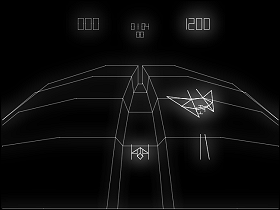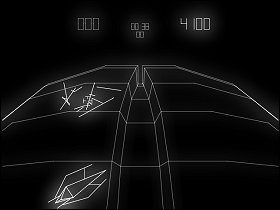 The Game: The player pilots a space fighter into an endless dogfight above a space station trench. Enemy ships attack from all directions, and even zip down the trench; and and all of these can be blasted into bits for points. Beware the fastest of these enemy fighters, which will appear with very little notice and fire directly at the player’s score, relieving it of points every time the fighter is successful with its attack! (Cinematronics, 1979)
The Game: The player pilots a space fighter into an endless dogfight above a space station trench. Enemy ships attack from all directions, and even zip down the trench; and and all of these can be blasted into bits for points. Beware the fastest of these enemy fighters, which will appear with very little notice and fire directly at the player’s score, relieving it of points every time the fighter is successful with its attack! (Cinematronics, 1979)
Memories: 1979 is the year that trench warfare – i.e. the Death Star trench – hit arcades and consoles alike. With the premiere of Star Wars in May 1977, game designers everywhere seemed to home in on the movie’s climactic flight through the Death Star trench as obvious video game material, and with good reason: the enclosed space offered plenty of hazards and limited room to maneuver, as well as the illusion of 3-D depth. As long as the hardware for a given project could handle the display requirements, the game play was a no-brainer – it had already been dictated by George Lucas and ILM. The only thing that kept the earliest variations on the Death Star trench theme from appearing immediately after the movie was the turnaround time for development, programming and manufacturing.
 Starhawk, another of Cinematronics‘ steady line of vector graphics games, was easily the sharpest-looking iteration of this emerging sub-genre of video games. The smoothly-scrolling, evenly-spaced lines defining the trench surface beneath the player were a very simple animation loop, but also surprisingly effective. In advertising material and other documentation for Starhawk, Cinematronics was still riding the “Vectorbeam” horse hard, reminding everyone that it had pioneered this “alternate means of visual display” for video games.
Starhawk, another of Cinematronics‘ steady line of vector graphics games, was easily the sharpest-looking iteration of this emerging sub-genre of video games. The smoothly-scrolling, evenly-spaced lines defining the trench surface beneath the player were a very simple animation loop, but also surprisingly effective. In advertising material and other documentation for Starhawk, Cinematronics was still riding the “Vectorbeam” horse hard, reminding everyone that it had pioneered this “alternate means of visual display” for video games.
What Starhawk didn’t pioneer, however, was variety of play: with only minimal exposure to the game, patterns become blindingly obvious, and even beginning players could rack up an impressive score. The answer to this, from a game design standpoint, seems to have been the brief appearances of a fighter that literally blasts points off of the player’s score. Granted, the availability of memory for something even remotely resembling “enemy  AI” was at a premium, but less repetition and more unpredictable enemy behavior would have made for a better game than an enemy ship whose sole purpose is to handicap the player’s score. Despite that, Starhawk is still a very pretty game to look at, even today.
AI” was at a premium, but less repetition and more unpredictable enemy behavior would have made for a better game than an enemy ship whose sole purpose is to handicap the player’s score. Despite that, Starhawk is still a very pretty game to look at, even today.